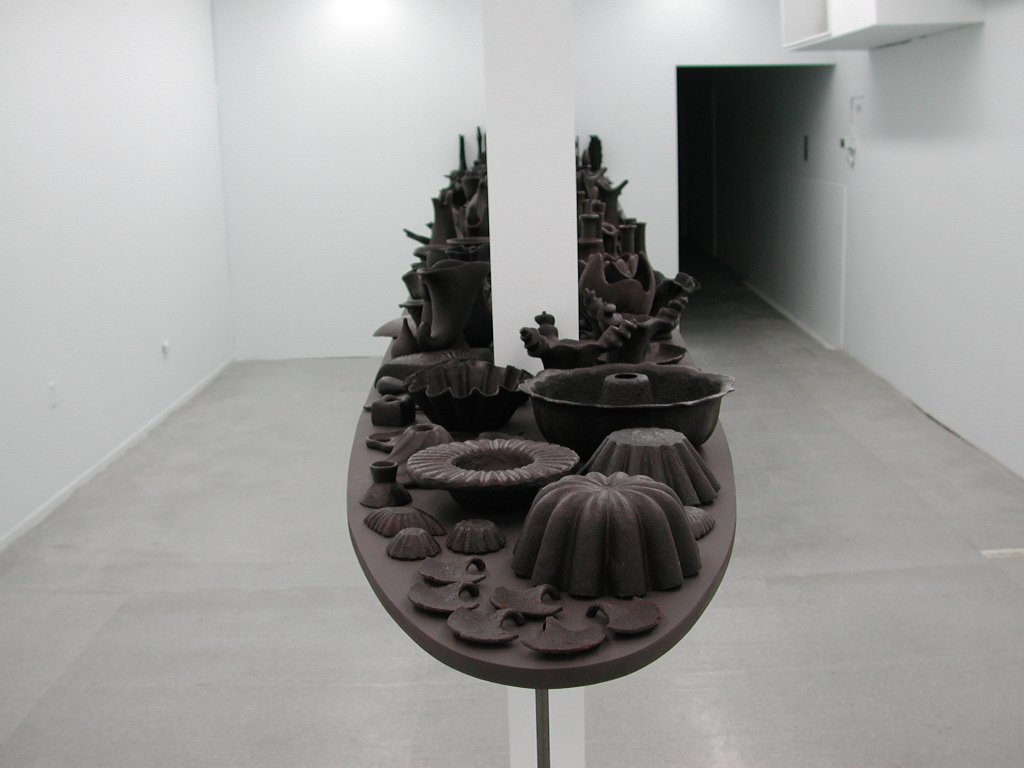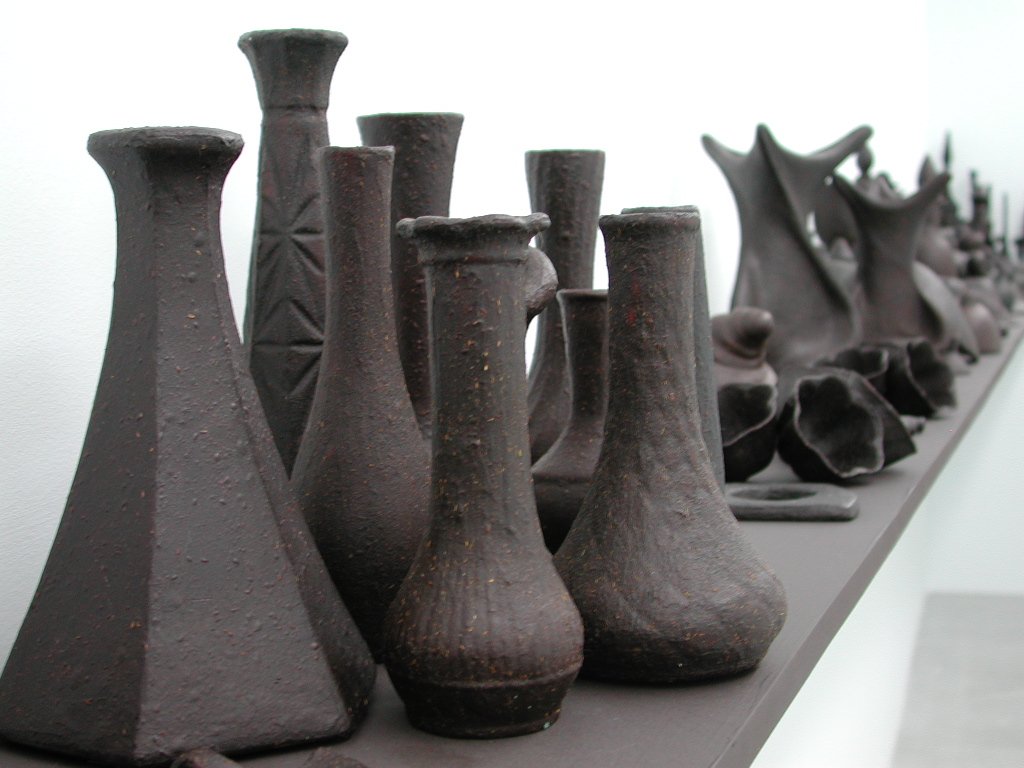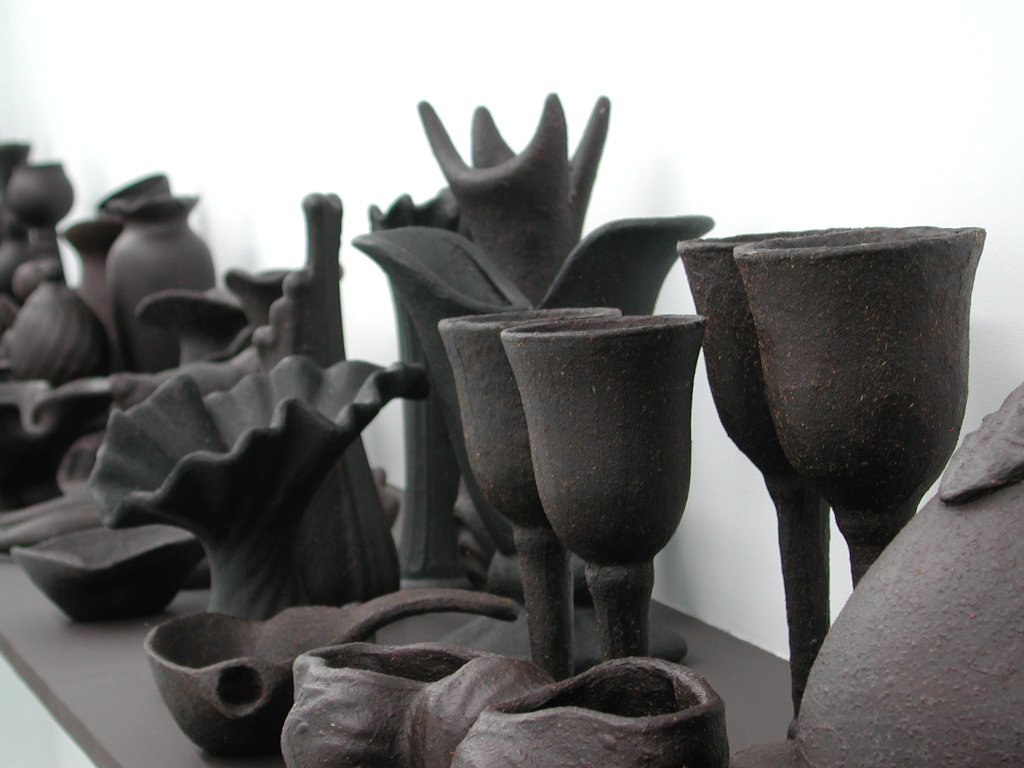Satiate /e(ate)n
[Shantz’s] objects acquire an outer skin made from the innards of the tomato … these encased objects that appear as a solid casts, but are actually hollow, double that meaning in their use of food to create implements that will in turn manipulate food … The table, the forms, and the materials can all be seen as a secular celebration of the trials and glories of domestic life, or, more likely, the trials and glories of artmaking as a woman. In all Shantz’s work the sense of material touch, the sensuous memory of making, is forcefully recalled by what has been made and is now seen, the ultimate transformation of private to public, internal to external. (Lucy Lippard, “Insight at Hand”, catalogue essay)
photo credit: Robert Keziere
Solo Exhibitions:
Satiate, Burnaby Art Gallery, Burnaby, B.C. 2000
Satiate, MacKenzie Art Gallery, Regina, SK 1998
Satiate, Southern Alberta Art Gallery, AB 1998
Group Exhibitions:
e(ate)n, Art Gallery of Hamilton, ON. In “Feast: Food in Art” 2005
e(ate)n, Expression Art Gallery, Ste. Hyacinthe, PQ. In “Orange” 2003
Works in Collection:
Art Gallery of Hamilton
MacKenzie Art Gallery
Publications:
Lucy Lippard, “Insight at Hand” in Satiate: Susan Shantz, Southern Alberta Art Gallery, 1998 + link to pdf of essay
Paradoxically, [Shantz’s] objects acquire an outer skin made from the innards of the tomato … these encased objects that appear as a solid casts, but are actually hollow, double that meaning in their use of food to create implement that will in turn manipulate food … The table, the forms, and the materials can all be seen as a secular celebration of the trials and glories of domestic life, or, more likely, the trials and glories of artmaking as a woman. In all Shantz’s work the sense of material touch, the sensuous memory of making, is forcefully recalled by what has been made and is now seen, the ultimate transformation of private to public, internal to external.
Renee Baert, “Insight at Hand” in Satiate: Susan Shantz, Southern Alberta Art Gallery, 1998 + link to pdf of essay
The artifacts upon the table are objects of process and transformation … whose original finishing has been bright colouration has been stripped bare by erosion and time, so the differentials of original colour and material of these found objects are brought to a unified, monochromatic colour field … a new order of visibility as a system of forms that bear a kind of archeological weight. Their earthen tones and ghost functionality highlight this sense of aged domestic artifacts retrieved – salvage objects suited to the appreciations of a museal gaze … a formalized archive of everyday cultural artifacts that reveal, not a distant past, but the idioms and graces of an immediate and living culture … Satiate, with its imaginary relays of inside and outside, organ and artifact, body and culture, models an ethos by which to imagine differently the structural and relational possibilities of scared ritual and social exchange.
Timothy Long, Susan Shantz: Satiate, MacKenzie Art Gallery, 1998 + link to pdf
The disturbance created by [Satiate] can be traced to the way it subverts the boundaries between what is interior and what is exterior … As the title implies, the work is about consumption … the obsessive accumulation of banal consumer goods … [so that] the consumer-viewer is metaphorically ingested – swallowed by the obsession with consumption … These objects are in fact the indigestible remains of our culture. They reveal the truth that despite our endless frenzy of consumption, nothing is digested, absorbed, or assimilated, but simply accumulated.
Mélanie Boucher, “Art, Theory and the Newfound Interest in Food,” + link to pdf + link: https://www.expression.qc.ca/orange/2003/artiste16_e.html
[e(ate)n] … consists of an installation that resembles a banquet table replete with recipients, dishes and other utensils, and recalls the art of hospitality … the tomato-paste covered vessels were red, like living flesh .. over time [they] turned purple, almost black … conjur[ing] up the transformation of the human body, aging and drying out as the years pass … With e(ate)n … we witness a changeover from container to contained and an inside-outing of the flesh … now in plain sight. By analogy it becomes ours. And being subject to putrefaction, it brings to mind our eventual death. Looking at it arouses feelings and emotions, and we are interpellated, touched at the very core of our being.










